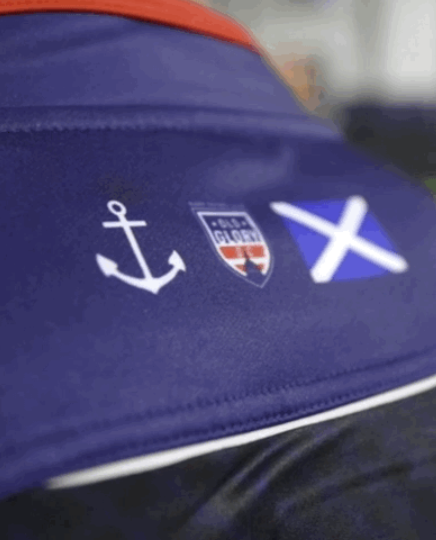A jersey is an essential part of any sports uniform and represents the team’s identity, values, and history. Beyond just being a functional piece of clothing, they often feature various symbols that hold significant meaning for the team and its fans. Symbols with purpose embodying our beliefs.
In this article we invite you to delve into the rich history and meaning behind Old Glory’s iconic jersey symbols and what they represent.


The anchor on our jerseys represents the spirit of Captain William Driver, the staunch American patriot who first named Old Glory and defended her throughout the Civil War, but who also embraced the people and cultures of the many countries around the world to which he voyaged during his seafaring career —countries which, today, reflect many of the great traditions of the global community of rugby.
Driver was gifted an American flag by his mother upon his first assignment as Captain of a merchant sea vessel in 1824. He immediately named her “Old Glory” and flew her above his ship on all his voyages thenceforward, to and around such places as the British Isles, New Zealand, Fiji, Australia, Argentina, and South Africa. His many adventures included transporting the survivors of the famous “mutiny on the Bounty” crew to their final refuge on Pitcairn Island. Upon his retirement in 1837, Driver settled in Nashville Tennessee, where he flew the now weather-beaten but still proud Old Glory above his home. Around this time, he added eight more stars to the flag for the eight states that had joined the Union during his nautical career, and he also added an anchor to commemorate his voyages and the countries he had come to love around the world. Now a loyal Unionist and abolitionist living among Southern sympathizers, Driver bravely continued to display Old Glory even after war broke out between the States, until threats from local Confederates persuaded him to hide her in order to protect her. Old Glory was sewn inside a quilt for the subsequent war years, until Union troops re-took the City of Nasvhille in 1862 and accepted Driver’s offer to fly her again, this time above the Tennessee Statehouse.
Today Old Glory is kept by the Smithsonian Institution in Washington, D.C. To the nation, the name “Old Glory” has become synonymous with the American flag; but to us, it represents the connection between our patriotism and our respect for the many countries around the world where Driver sailed, and which today embrace great traditions of rugby. The connection between Driver’s story and the culture of rugby may be singaled by a couple of interesting coincidences: Rugby legend tells us that Wiliam Webb Ellis first picked up a soccer ball in his hands “with fine disregard for the rules of the game” and charged toward the goal at the Rugby School in England in the year 1823. We like to think that, at that very moment, thousands of miles away in Salem Massachusetts, Captain Driver’s mother had begun to sew the flag she’d bestow on her son less than a year later. And indeed, the lands which Old Glory then visited include all the countries from which players on our 2023 roster have hailed.

The shield of Old Glory DC is meant to represent the most defining characteristic of our region: service to our country. Whether directly or indirectly, the people of greater Washington are part of a diversified and growing regional economy, born from and supporting the core of our nation’s government. Our neighbors and friends serve in the military, or in federal agencies, or work with the many government contractors and suppliers who comprise so many of the businesses in our region, or they may be among the teachers, accountants, construction workers, or endless other professions who contribute to the dynamic market that sustains it all.
We therefore choose the American flag as the basis of our shield. But it’s not just any American flag – it’s a very unique and specific one: Old Glory. Old Glory is a real flag kept at the Smithsonian Institution in downtown D.C. It is historic. It is weather-beaten and war-torn. It’s been places and seen things, all around the world and in every condition of climate and weather, geography and culture. Time and again, Old Glory has remained steadfast in the face of all challenges and adversity, always to persevere. In short, it reflects the spirit of rugby, and now it rests in the heart of our home town.
Rugby is unique among team sports in its embrace of values, which are recognized universally throughout the global rugby community. The examples of these are well known, including the contrast between the intensity and physical contact of the game and the formal respect always shown for game officials, as well as the coming together of the toughest opponents for the comradery of a shared meal after the battle is done.
Our shield represents Old Glory’s role as the connection between the community of greater Washington and the global community of rugby. For us, it symbolizes the values we embrace:
Inclusion. Rugby is for everyone. Our words and actions foster a sense of belonging
and togetherness.Respect. Rugby is a global sport. We come from all walks of life but respect our teammates,
officials, opponents, and, most importantly, the game.Community. Rugby is a brotherhood and sisterhood that extends throughout the world. Our supporters, partners, regional players and coaches from the youth through seniors levels, and our counterparts in countries around the globe are all part of the Old Glory family.
Integrity. Rugby demands honor. We do right, speak honestly, and hold ourselves and each other accountable.
Passion. Rugby is a lifestyle built on commitment. Our love for it is evident in everything we do.

The Scottish flag on our jersey is a reminder of the strength we draw from our partnership with the Scottish Rugby Union. The “SRU,” or “Scottish Rugby,” is a part owner of Old Glory DC, having not only invested in our organization but also having built connections with us to support our operations both on the pitch and off, making available to us the tremendous resources of one of the longest-established, most storied and distinguished rugby unions in the world.
Building on a tradition that began with history’s first international rugby match, won by Scotland over England in 1871, Scottish Rugby is today one of the most respected unions among Tier One rugby nations. However, the SRU is not only the national governing body of rugby in Scotland, but also the owner of two professional teams (Edinburgh and the Glasgow Warriors, both of whom compete in the United Rugby Championship or URC, and the European Professional Club Rugby or EPCR Heineken Cup Championship), and the holder of ownership positions and leadership roles in such rugby properties as the Six Nations Tournament and with World Rugby.
Scottish Rugby holds a seat on Old Glory’s board, participates in our strategic decision-making, and has provided various forms of developmental support for our organization. For example, our focus on development of home-grown American players has been supported by the deployment of up-and-coming players to training camp with the Glasgow Warriors during Major League’s Rugby’s off-season which coincides with the URC’s pre-season. Such Old Glory heroes as Jack Iscaro, Cory Daniel, John Rizzo, and Owen Sheehy have participated in this program and consider it among the best rugby development opportunities of their careers to date. Additionally, the SRU’s top Performance personnel have participated in and supported Old Glory’s decision-making around coaching, player recruitment, and rugby operation. Old Glory’s General Manager Marcelo Blanco ensures that every department in Old Glory’s front office maintains communication and coordination with their counterparts at the SRU.
The Scottish flag or “Saltire” is a white diagonal cross on a blue field, representing the cross of St. Andrew, a symbol of Scotland said to date back as far as the year 832.






